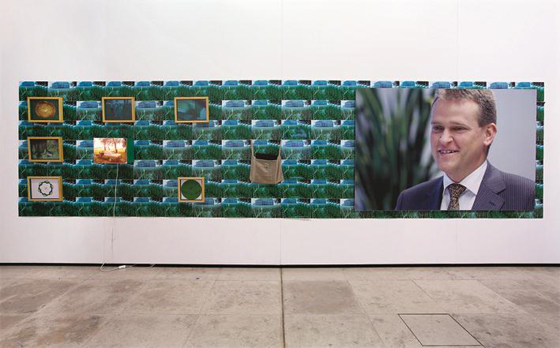|
|
| We are Contemporary Iliana Veinberga, Art Critic Lithuanian Contemporary Art Exhibition "Vilnius Art Scene after 2000" 05.12.2008.-18.01.2009. Latvian National Museum of Art, Exhibition Hall Arsenāls | |
| The first impression of the exhibition "Vilnius Art Scene" (curator Raminta Jurenaite) is eclecticism - a typical weakness of shows that attempt to exhibit a "retrospective representation and general overview". Here we see an assortment of media, a range of themes, subjects and motives, and artwork intended for different target audiences, the only common denominator being that the art is created by artists who work in Vilnius or who are originally from Vilnius. Conceptually such a choice is rather slippery due to a number of reasons, however, the fundamental argument by the organizers is clearly stated: in 2009 Vilnius is going to be the European Capital of Culture, and this is an unorthodox "commercial" to showcase the "vitality and diversity of the art scene" in Vilnius. Nonetheless, while viewing the exposition, I was overcome by a certain sense of dullness. It was a typical, unimpeachable show of contemporary art. The elements of form and thematic boundaries of the works seamlessly matched the requirements of Western art, which is fixated on critical art theory. No big surprises, no huge disappointments. In essence the exposition, as a whole, lacked focus - in place of interpretation we were offered a catalogue. Hence the exhibition did not become a phenomenon, nor did it create a vibrant image of a phenomenon. Instead, various elements and pieces were grouped together, similarly as Frankenstein was created from separate body parts. A good use of time was to view the exhibition according to the grouping of works into three main trends - 1) politically and socially engaged art, 2) the New Realism and 3) New Abstract Art. In other words, these are trends that "dominate the art scene since the decline of the conceptual art movement". The curator offers the criterion for her choices: "the artists represent fundamental trends of contemporary art in their creative work". This calls forth a heretical question - do our accomplishments automatically become meaningful if we do things the same way they are done in large art centres? | |
 Heinz-Hermann Jurczek. XXX. Acrylic on canvas. 160x300. 2008. Photo: Martins Vizbulis | |
| Viewing the exhibition without having read the catalogue introduction was not as useful, although quite fascinating. Was it important to find out about the level of national engagement and the national character of this exhibition? Twenty-three authors with more than forty works of art. Each work of art - unique, and it is a pity that there was no accompanying description of the idea or the context. Of course, a work of art has to speak for itself, and many of them were truly expressive, however, wishing to find out what exactly the "Vilnius art scene" is all about, some sort of rudimentary information would have been much more convincing than the statements that Vilnius also has the same "neo-isms" that can be observed in the postconceptualism of the civilized Western world.
Several works inspired a desire to find out about the situation in Lithuania, more precisely in Vilnius. What are the conditions of the artist's creative life and its continuity that has made the artwork worthy of recognition? There were pieces where the lack of context made it difficult to understand the essence of the work, for example, "Autumn" by Agnė Bagdžiūnaitė and Domas Noreika. However, the majority of works prompted a wish to find out more about their creators. My mind began to hatch a mischievous scheme: it would have been better to have solo shows by all these artists under the same roof, using the same exhibition title - that would be the only way to sate my viewer's appetite. Even though there was no artwork worthy of the avantgarde title, there were a number of showpieces that provided truly lasting satisfaction with their interplay of subject and form: "Permanent and Flexible" by Rimantas Milkintas, and especially his work "Untitled" - semantically grandiose, and to be interpreted in the context of political history; a piece by Martynas Martišius "Kitchen", oversaturated with textual quotes; Eglė Ridikaitė's filigree work "Okune's dream" and "2005.01.12"; Laima Buivydaitė's poignant message to an unborn son "For Your Sake"; both pieces by Zavadskis, as kunstkamera and archive fever commentaries; Heinz-Hermann Jurczek's "Experiment" and "Emergency Exit". | |
 Agne Bagdžūnaite, Doms Noreika. Autumn. Photoinstallation. 2008. Photo: Martins Vizbulis | |
| Every work could be worthy of mention, however, the exhibition touched me personally only during subsequent visits, when it caught at my national heartstrings. Here, of course, we could have a discussion about the local, national and global aspects, and whether or not it is appropriate to use these notions with regard to contemporary art, etc. But there is one thing I am sure about - indirect and direct aspects of nationalism (political and social history, and its manifestation in cultural artefacts) in several works of this exhibition gave this show the necessary authenticity. The quoting and paraphrasing nature of non-avantgarde contemporary art is in its essence decadent, thus this type of art can captivate someone's attention only due to the originality of form (which is simultaneously the interpretation of the theme). The competition on the global art scene is colossal, therefore being unabashed about local peculiarities sometimes allows to add a substantial and genuine dimension to works of art, making them "our own". Maybe even making the whole exhibition "our own". /Translator into English: Anita Načisčione/ | |
| go back | |







